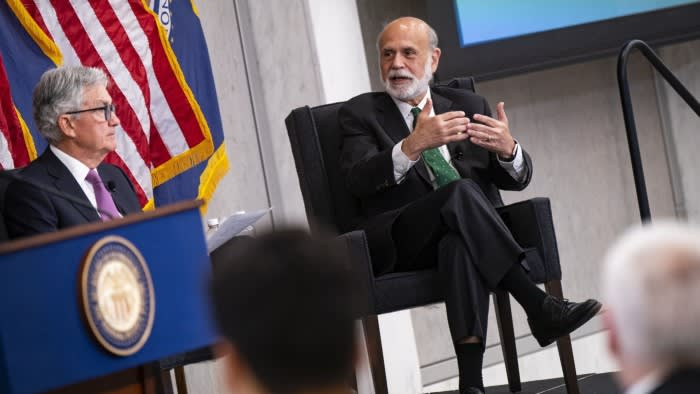Unlock the Editor’s Digest for free
Roula Khalaf, Editor of the FT, selects her favourite stories in this weekly newsletter.
The writer, an FT contributing editor, is chief executive of the Royal Society of Arts and former chief economist at the Bank of England
In the early years of inflation targeting in the UK, the then head of forecasting at the Bank of England entered my room clutching a piece of paper. On it were two lines: the inflation forecast produced painstakingly by his team over the preceding weeks, and an alternative inflation projection hand-drawn in pencil by the then governor. Only the latter “forecast” ever saw the light of day.
Since then, governors and monetary policymakers have come and gone, each bearing different pencils. But the process of economic forecasting has remained essentially unchanged: largely performative, typically opaque, nine parts art to one part science. The recent review of forecasting by Ben Bernanke, former chair of the US Federal Reserve, while full of sound recommendations, is unlikely to alter that.
It was all meant to be so different. At the outset of inflation targeting, the use of inflation forecasts was deemed a breakthrough. The long and variable lags of monetary policy mean it is only by responding to inflation one to two years ahead that timely decisions can be made about interest rates today. Inflation forecasts became the pivot point for monetary policy. The second breakthrough was to have those projections produced, consistently and coherently, courtesy of an economic model. This served as a disciplining device on the whims of policymakers. In that sense, inflation forecasting was a key constraint in the “constrained discretion” of inflation targeting.
Future inflation is of course uncertain. Former central bank governor Mervyn King used to observe that the probability of forecasts proving correct was almost precisely zero. (Ironically, this is one of the few BoE forecasts ever made that turned out to be accurate.) That led many central banks to quantify and illustrate this uncertainty, in the BoE’s case through so-called “fan charts”.
In time, several central banks — although not the BoE — published interest rates projections, alongside inflation and growth, revealing more of policymakers’ future hands. The Fed’s “dot plots” are one example and have become the centrepiece of its monetary policy communications.
Full disclosure, there was no more effusive advocate of this new monetary policy technology than me. And inflation targeting itself has performed far better than anyone could ever have expected in anchoring inflation expectations. But, truth be told, inflation forecasting has been incidental to this success. This is not (or not only) because models and their forecasts have been wrong, often very wrong. That comes with the territory. It is because inflation forecasting has in practice imposed the wrong sorts of policy constraint.
Economic models bring rigour to policy. Unfortunately, they also bring mortis. Even models at the frontier are always at least one step behind real-world events: from the global financial crisis (when most were found to take no meaningful account of the financial sector) to the Covid-19 and cost of living crises (when most were found to have no well-developed sectoral supply side). In these instances, models served to unhelpfully blinker policymakers to events playing out before their eyes, but not embedded in their models. This led to them first missing these crises, and then responding too slowly.
Those models can also be gamed in ways that impose too few constraints on policy. In my experience, many policymakers produced their economic forecasts by working backwards from their preferred stance. This is an inversion of the way inflation targeting was meant to operate.
Bernanke’s diagnosis and recommendations are sound. The bank’s fans, like those in a fan dance, were used largely to preserve the dignity of the dancer and avoid audience embarrassment. Their suggested replacement, with defined scenarios, will deliver a more revealing performance, while still leaving the audience largely in the dark.
Publishing forward interest rate paths — neither recommended nor ruled out by Bernanke — would alter the bank’s policy communications more fundamentally. They would make explicit what is currently often implicit. Whether this is helpful is another matter. For me, it risks an over-reliance on, and over-sensitivity to, central bank signals, as Fed experience illustrates.
John Kenneth Galbraith famously said economics was extremely useful — as a method of employment for economists. The same could be said of inflation forecasts and central bankers. For all Bernanke’s sound analysis, forecasting is likely to remain interpretive dance — always mysterious, occasionally enlightening, a show without much tell.

